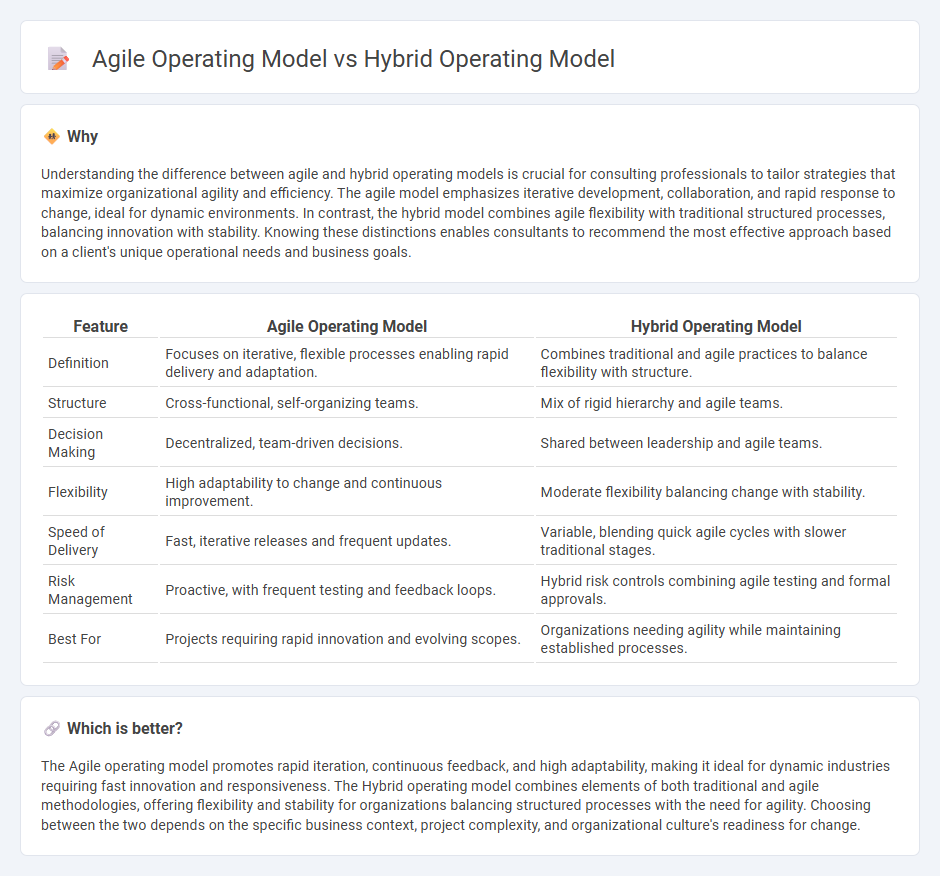
Agile operating models prioritize flexibility, iterative progress, and rapid response to change, empowering teams to deliver continuous value through adaptive planning and collaboration. Hybrid operating models combine traditional hierarchical structures with agile practices, optimizing stability while enhancing responsiveness and innovation. Explore how choosing the right model can transform your organization's efficiency and competitive edge.
Why it is important
Understanding the difference between agile and hybrid operating models is crucial for consulting professionals to tailor strategies that maximize organizational agility and efficiency. The agile model emphasizes iterative development, collaboration, and rapid response to change, ideal for dynamic environments. In contrast, the hybrid model combines agile flexibility with traditional structured processes, balancing innovation with stability. Knowing these distinctions enables consultants to recommend the most effective approach based on a client's unique operational needs and business goals.
Comparison Table
| Feature | Agile Operating Model | Hybrid Operating Model |
|---|---|---|
| Definition | Focuses on iterative, flexible processes enabling rapid delivery and adaptation. | Combines traditional and agile practices to balance flexibility with structure. |
| Structure | Cross-functional, self-organizing teams. | Mix of rigid hierarchy and agile teams. |
| Decision Making | Decentralized, team-driven decisions. | Shared between leadership and agile teams. |
| Flexibility | High adaptability to change and continuous improvement. | Moderate flexibility balancing change with stability. |
| Speed of Delivery | Fast, iterative releases and frequent updates. | Variable, blending quick agile cycles with slower traditional stages. |
| Risk Management | Proactive, with frequent testing and feedback loops. | Hybrid risk controls combining agile testing and formal approvals. |
| Best For | Projects requiring rapid innovation and evolving scopes. | Organizations needing agility while maintaining established processes. |
Which is better?
The Agile operating model promotes rapid iteration, continuous feedback, and high adaptability, making it ideal for dynamic industries requiring fast innovation and responsiveness. The Hybrid operating model combines elements of both traditional and agile methodologies, offering flexibility and stability for organizations balancing structured processes with the need for agility. Choosing between the two depends on the specific business context, project complexity, and organizational culture's readiness for change.
Connection
The agile operating model emphasizes iterative workflows, rapid feedback, and adaptability, which complement the hybrid operating model's integration of both traditional and agile practices to optimize business outcomes. By combining these frameworks, organizations can leverage the flexibility of agile methods while maintaining structured processes suited for complex or regulated environments. This synergy enhances responsiveness to market changes and fosters effective collaboration across diverse teams.
Key Terms
Governance Structure
The hybrid operating model blends traditional hierarchical governance with agile principles, enabling organizations to maintain control while fostering flexibility in decision-making processes. Agile operating models emphasize decentralized governance, empowering cross-functional teams with autonomy to enhance responsiveness and innovation. Explore deeper insights into how governance structures shape operational efficiency and adaptability in both models.
Decision-Making Autonomy
Hybrid operating models balance centralized and decentralized decision-making, allowing flexibility based on organizational needs. Agile operating models emphasize high decision-making autonomy within cross-functional teams to enhance responsiveness and innovation. Explore how these approaches impact organizational efficiency and adaptability by learning more about their decision-making frameworks.
Team Integration
The hybrid operating model blends traditional hierarchical structures with agile principles, enabling team integration through defined roles and flexible collaboration paths. In contrast, the agile operating model emphasizes cross-functional teams working iteratively with continuous feedback, promoting adaptability and real-time problem solving. Explore deeper insights on optimizing team integration within these models to enhance organizational performance.
Source and External Links
Hybrid Operating Model 4.0 - SIA Partners - This model segments an organization's value chains by product category to balance fast, automated delivery of standardized products and high-quality customization, aiming to optimize both costs and profits with improved agility and strategic alignment.
Hybrid Operating Mode a New Working Model for Companies : Aalpha - Describes a hybrid operating mode that integrates remote and office-based work tailored to employee preferences, emphasizing technology's role in enhancing customer-company interactions and adapting to pandemic-driven changes.
The hybrid working model explained: what is it and how does it work? - Defines the hybrid working model as a flexible work arrangement combining remote and office work that benefits employees with autonomy and work-life balance, and employers with cost savings, productivity gains, and expanded talent access.
 dowidth.com
dowidth.com